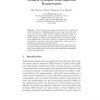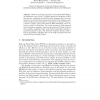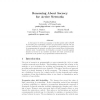109
Voted
ROOM
2000
15 years 1 months ago
2000
The Unified Modeling Language (UML) has been designed to be a full standard notation for Object-Oriented Modelling. UML is a rather complete set of notations, but it lacks of form...
COLING
2000
15 years 1 months ago
2000
We present a formal semantics for an objectoriented formalism which allows for the representation of plural objects (such as `Three N', `Most of the N', `Some N',.....
113
click to vote
SAM
2004
15 years 1 months ago
2004
Discovering faults in requirements specifications for distributed reactive systems is a challenging problem since many issues that need to be uncovered are a result of subtle compo...
NAACL
2004
15 years 1 months ago
2004
We propose a theory that gives formal semantics to word-level alignments defined over parallel corpora. We use our theory to introduce a linear algorithm that can be used to deriv...
122
click to vote
ER
2008
Springer
15 years 2 months ago
2008
Springer
Due to a turbulent market enterprises should be able to adapt their business processes in a quick and flexible way. This requires adaptive process-aware information systems (PAISs)...
124
click to vote
ECMDAFA
2006
Springer
15 years 4 months ago
2006
Springer
Abstract. The Unified Modelling Language (UML) is intended to describe systems, but it is not clear what systems satisfy a given collection of UML diagrams. Stephen Mellor has desc...
DBPL
2007
Springer
15 years 4 months ago
2007
Springer
Abstract. Formal semantics for XQuery with side-effects have been proposed in [13, 16]. We propose a different semantics which is better suited for database compilation. We substan...
138
Voted
DOOD
1997
Springer
15 years 4 months ago
1997
Springer
With the increasing importance of the World Wide Web as an information source, there is a growing interest for integration of Web and database technology. Several Web query languag...
114
click to vote
KBSE
1997
IEEE
15 years 4 months ago
1997
IEEE
Given a program S and a precondition Q, the strongest postcondition, denoted sp(S Q), is defined as the strongest condition that holds after the execution of S, given that S term...
105
click to vote
CSFW
2000
IEEE
15 years 4 months ago
2000
IEEE
In this paper we develop a language of mobile agents called uPLAN for describing the capabilities of active (programmable) networks. We use a formal semantics for uPLAN to demonst...



